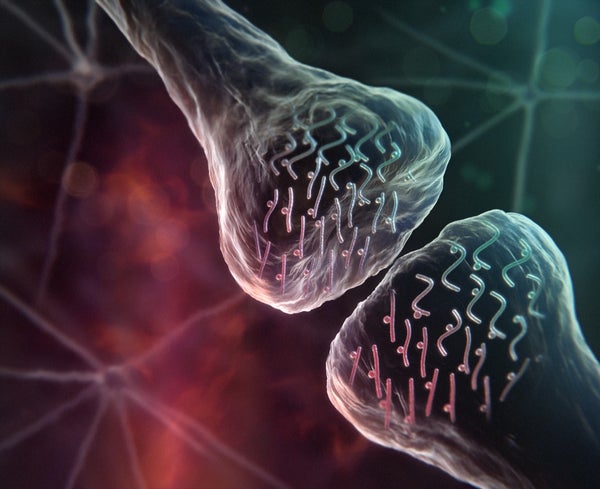Most of us could use more sleep. We feel it in our urge for an extra cup of coffee and in a slipping cognitive grasp as a busy day grinds on. And sleep has been strongly tied to our thinking, sharpening it when we get enough and blunting it when we get too little.
What produces these effects are familiar to neuroscientists: external light and dark signals that help set our daily, or circadian, rhythms, “clock” genes that act as internal timekeepers, and neurons that signal to one another through connections called synapses. But how these factors interact to freshen a brain once we do sleep has remained enigmatic.
Findings published on October 10 in two papers in Science place synapses at center stage. These nodes of neuronal communication, researchers show, are where internal preparations for sleep and the effects of our sleep-related behaviors converge. Cellular timekeepers rhythmically prep areas around the synapses in anticipation of building synaptic proteins during slumber. But the new findings indicate neurons curtail their regular on-off cycles of building these critical proteins in the absence of sleep.*
On supporting science journalism
If you're enjoying this article, consider supporting our award-winning journalism by subscribing. By purchasing a subscription you are helping to ensure the future of impactful stories about the discoveries and ideas shaping our world today.
The results suggest the brain is “getting prepared for an event, but it doesn’t mean you actually follow through on doing it,” says Robert Greene, a neuroscientist at the University of Texas Southwestern Medical Center, who was not involved in the study. Greene calls the studies “fascinating,” saying they confirm a “long suspected” connection between internal timekeeping and sleep behaviors.
When we become sleepy, two factors are in play: “sleep pressure,” or the growing allure of a beckoning pillow as waking time lengthens, and our internal clock sounding the signal that the usual point for shut-eye has arrived. In one of the two studies, Sara B. Noya of the Institute of Pharmacology and Toxicology at the University of Zurich and her colleagues showed that in mice, the internal clock regulates the rhythmic generation of instructions, or transcripts, for making proteins. Giving in to sleep pressure and hitting the hay, they found, triggers the final steps of protein production.
At two peak times in the 24-hour day, just before waking and sleeping, neurons in cognition-related brain areas packed a timekeeping cell’s signaling stations with these transcripts, Noya’s team discovered. The “sleep time” transcripts tended to be for proteins that regulate building other proteins, while the “wake time” instructions were for proteins linked to synapse function. These stashed molecules set the stage for the rapid refreshing of synapses during sleep. Mice lacking important clock genes did not show these peaks.
With a regular sleep-wake cycle, the proteins built using these instructions also showed peak production at dawn and dusk. In sleep-deprived mice, however, Noya and her colleagues demonstrated that the cell still produced many of the transcripts but did not build the related proteins. That result implies sleeping regulates the final, protein-building step in ensuring robust synapses.
Not all proteins that the cell makes necessarily go into active service, though. In a companion paper, Franziska Brüning of the Ludwig Maximilian University of Munich and the Max Planck Institute of Biochemistry in Martinsried, Germany, and her colleagues explored the rhythmic use of those that do. Attachment or removal of a phosphate molecule acts as a toggle to turn proteins on or off, so the investigators took a close look at this process. They found levels of proteins that had been tagged with phosphates also peaked twice, with the bigger peak occurring just before waking. And as with proteins in the other study, sleep deprivation flattened these peaks.
The researchers made their measurements every four hours, an advance on earlier studies that usually looked at a single time point during a 24-hour period, says Chiara Cirelli, a neuroscientist at the University of Wisconsin–Madison, who co-wrote a commentary accompanying the two papers. “It’s a very comprehensive analysis across the entire light-dark cycle,” she says.
Cirelli emphasizes the importance of isolating the synaptic regions where these molecules accumulate and are produced. The researchers pinned down when transcripts were positioned at the ready and when proteins—tagged with phosphates or not —were made or used, she says.
Maria Robles, a neuroscientist at Ludwig Maximilian University of Munich and a co-author of both papers, says the findings distinguishing the different stages of protein production and activity are eye-opening, revealing the brain has “a beautiful way to control” these molecules.
Even though the studies were done in mice, the brains of these animals have proved to be pretty reliable substitutes for those of humans, says Akhilesh B. Reddy, a neuroscientist at the Perelman School of Medicine at the University of Pennsylvania, who was not involved in the work. The findings have implications for how we consolidate memories during sleep, among other promising avenues of research, he says, drawing the focus straight to events at the synapse. That does not mean, however, that interventions to boost memory and cognition loom in the near future, based on these findings, Robles says. “This is just the tip of the iceberg,” she adds.
*Editor’s Note (10/16/19): This sentence was edited after posting to better clarify how neurons are affected by sleep deprivation.
